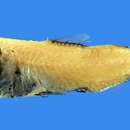Diagnostic Description
provided by Fishbase
Total anal organs 8-10; three to 6 small elongate patches of luminous tissue along base of anal fin which originate at the 4th ray; supracaudal gland short, with 2-3 scales, infracaudal gland with 3-5 scales reaching below last or next to last posterior anal organ (Ref. 39633).
- Recorder
- Cristina V. Garilao
Morphology
provided by Fishbase
Dorsal spines (total): 0; Dorsal soft rays (total): 12 - 14; Analspines: 0; Analsoft rays: 12 - 15
- Recorder
- Cristina V. Garilao
Biology
provided by Fishbase
High-oceanic species found between 375 and 750 during the day and between 40 and 650 at night (Ref. 4775). Mesopelagic (Ref. 75154). Large individuals are non-migratory (Ref. 4775).
Comprehensive Description
provided by Smithsonian Contributions to Zoology
Bolinichthys supralateralis
This species, a questionably tropical-subtropical myctophid in the Atlantic, is known to occur in tropical and subtropical waters of the Indian Ocean, off Australia, and near Hawaii (Nafpaktitis et al., 1977). It is a large lanternfish reaching 117 mm (Hulley, 1981); maximum length in the Ocean Acre collections is 97 mm. This “uncommon” lanternfish was represented in the collections by a total of 107 specimens, 36 from IKMT's and 71 from Engle trawls. Six of the 16 specimens taken during the paired seasonal cruises were caught in discrete-depth, noncrepuscular tows (Table 23).
DEVELOPMENTAL STAGES.—Juveniles were 11–51 mm, subadults 39–91 mm, and the single adult (a female) 97 mm. Most fish smaller than 30 mm SL could not be sexed, but most of those larger could. The adult female contained ova up to 0.3 mm in diameter, but most were 0.1–0.2 mm. Johnson (1975) indicated that there is no external sexual dimorphism, but Nafpaktitis et al. (1977) noted that the size of the infracaudal luminous gland may be sexually dimorphic. There may also be sexual dimorphism in size. The four largest fish (83–97 mm) in the collections were females; the largest male was a 74 mm subadult. Because only six specimens larger than 70 mm were caught, five of which were subadults, the apparent dimorphism may be the result of the paucity of large specimens.
Females were slightly, but not significantly, more numerous than males in the collections (41 vs 32, respectively; chi-square = 1.1, p nearly equal to 0.3).
REPRODUCTIVE CYCLE AND SEASONAL ABUNDANCE.—The reproductive status and life span of B. supralateralis in the study area are uncertain. The small juveniles (smaller than 20 mm) and adult females present in the collections suggest that spawning may occur near Bermuda, and the size-frequency distribution (showing three size classes, see below) of all specimens caught in late summer (including those taken by the Engel trawl) suggests a life span of at least two years.
Apparently the parent population has a restricted breeding season. Small juveniles (smaller than 20 mm) were caught only in late summer and fall, suggesting that spawning occurs in late spring to early summer.
Large fish (larger than 50 mm) were caught in February, April, June, and August, and may have been present, but not sampled, throughout the year. The ineffectiveness of the IKMT in sampling large fish of this species was evident when collections taken in late summer were compared with the Engel trawl catches. IKMT samples from three cruises contained 16 fish 12–42 mm, with only the largest specimen in excess of 20 mm, and Engel samples from a single cruise contained 71 specimens 35–97 mm. Presumably, the IKMT samples large fish equally poorly at all seasons.
Specimens caught in late summer comprise at least three size classes, which may represent spawning classes: recruits 12–20 mm caught only with the IKMT; 35–74 mm fish most of which probably were one year old; and 91–97 m fish at least two years old. The intermediate group may have two size classes (35–54 mm and 56–77 mm), but there were too few specimens to be certain.
VERTICAL DISTRIBUTION.—One fish was caught in a discrete-depth day sample at 601–650 m in late summer. Night depths of occurrence were 701–750 m in winter and 201–300 m in late summer. All positive Engel collections were from deeper than 650 m, both day and night.
Apparently fish larger than about 35 mm undergo little, if any, diel shift in depth; all such specimens were taken in nets that fished deeper than 650 m. Smaller individuals (12–16 mm) may be vertical migrants in late summer. Some were taken at 201–300 m at night and others were caught below 450 m by day and during crepuscular periods.
- bibliographic citation
- Gibbs, Robert H., Jr. and Krueger, William H. 1987. "Biology of midwater fishes of the Bermuda Ocean Acre." Smithsonian Contributions to Zoology. 1-187. https://doi.org/10.5479/si.00810282.452
分布
provided by The Fish Database of Taiwan
分布於世界三大洋熱帶及亞熱帶海域。臺灣則發現於東沙群島周邊水域。
利用
provided by The Fish Database of Taiwan
一般以底拖網捕獲,不具食用經濟價值,通常做為下雜魚用。
描述
provided by The Fish Database of Taiwan
體延長,側扁。頭中大。吻鈍圓而不突出。眼大;眼球後部虹膜具新月形發光組織。口頗大,上頜末端延伸至前鰓蓋後緣;上下頜、鋤骨、腭骨、中翼骨及舌面均具齒,下頜後部另具數個強鉤狀齒。體被弱圓鱗,易脫落;側線平直。背鰭單一,位於體中部,具軟條12-14,後部另具一脂鰭;臀鰭基底略長於背鰭基底,具軟條13-15;尾鰭叉形,尾鰭副鰭條無硬棘。各部位之發光器位置於下:鼻部背位發光器(Dn)無;鼻部腹位發光器(Vn)小而圓形;鰓蓋位發光器(Op)2個,位於前鰓蓋後緣下方,Op1明顯較Op2小;鰓被架位發光器(Br)3個;胸鰭上方發光器(PLO)緊臨側線上緣;胸鰭下方發光器(PVO)2個,PVO1在PVO2的略前下方;胸部發光器(PO)5個,PO3略為昇高,PO4更高,約與PVO1同高;腹部發光器(VO)5個,VO2和VO3同高;腹鰭上位發光器(VLO)位於腹鰭和側線之中間略上方,不緊貼側線;臀鰭上方發光器(SAO)3個,三者排列呈鈍角狀,SAO1位於VO5的稍後上方,SAO3緊臨側線的上緣;體後側位發光器(Pol)2個,呈斜線排列,Pol1位於AOa列的後上方,Pol2在脂鰭下方,在側線上緣;臀鰭前部發光器(AOa)5-6個,沿臀鰭基底水平狀排列;臀鰭後部發光器(AOp)3-4個,沿尾柄腹側狀排列;尾鰭前位發光器(Prc)3個,呈2+1方式排列,Prc2位置略高於Prc1,且在其後方,Prc3在側線上緣;尾上腺(SUGL)具2-3覆瓦狀發光鱗;尾下腺(INGL)具3-5覆瓦狀發光鱗。此外,除臀鰭的第4軟條上方具3-6個發光鱗外,其餘在頭部及身體無發光組織。
棲地
provided by The Fish Database of Taiwan
大洋性中、底層巡游魚類,具日夜垂直分布習性,白天一般白天棲息於375-750公尺處,晚上則上游至水深40-650公尺附近處覓食,以浮游動物為食。
Distribution
provided by World Register of Marine Species
in tropical waters north to about 40°N; also between 34°S and 40°S
North-West Atlantic Ocean species (NWARMS)
- license
- cc-by-4.0
- copyright
- WoRMS Editorial Board
Habitat
provided by World Register of Marine Species
High-oceanic species found between 375 and 750 during the day and between 40 and 650 at night. Large individuals are non-migratory.
North-West Atlantic Ocean species (NWARMS)
- license
- cc-by-4.0
- copyright
- WoRMS Editorial Board
Habitat
provided by World Register of Marine Species
nektonic
North-West Atlantic Ocean species (NWARMS)
- license
- cc-by-4.0
- copyright
- WoRMS Editorial Board

